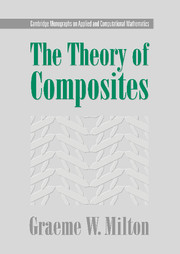Book contents
- Frontmatter
- Contents
- List of figures
- Preface
- 1 Introduction
- 2 Some equations of interest and numerical approaches to solving them
- 3 Duality transformations in two-dimensional media
- 4 Translations and equivalent media
- 5 Some microstructure-independent exact relations
- 6 Exact relations for coupled equations
- 7 Assemblages of spheres, ellipsoids, and other neutral inclusions
- 8 Tricks for generating other exactly solvable microgeometries
- 9 Laminate materials
- 10 Approximations and asymptotic formulas
- 11 Wave propagation in the quasistatic limit
- 12 Reformulating the problem of finding effective tensors
- 13 Variational principles and inequalities
- 14 Series expansions for the fields and effective tensors
- 15 Correlation functions and how they enter series expansions†
- 16 Other perturbation solutions
- 17 The general theory of exact relations and links between effective tensors
- 18 Analytic properties
- 19 Y-tensors
- 20 Y-tensors and effective tensors in electrical circuits†
- 21 Bounds on the properties of composites
- 22 Classical variational principle bounds
- 23 Bounds from the Hashin-Shtrikman variational inequalities
- 24 Bounds using the compensated compactness or translation method
- 25 Choosing the translations and finding microgeometries that attain the bounds†
- 26 Bounds incorporating three-point correlation functions†
- 27 Bounds using the analytic method
- 28 Fractional linear transformations as a tool for generating bounds†
- 29 The field equation recursion method†
- 30 Properties of the G-closure and extremal families of composites
- 31 The bounding of effective moduli as a quasiconvexification problem
- Author index
- Subject index
Preface
- Frontmatter
- Contents
- List of figures
- Preface
- 1 Introduction
- 2 Some equations of interest and numerical approaches to solving them
- 3 Duality transformations in two-dimensional media
- 4 Translations and equivalent media
- 5 Some microstructure-independent exact relations
- 6 Exact relations for coupled equations
- 7 Assemblages of spheres, ellipsoids, and other neutral inclusions
- 8 Tricks for generating other exactly solvable microgeometries
- 9 Laminate materials
- 10 Approximations and asymptotic formulas
- 11 Wave propagation in the quasistatic limit
- 12 Reformulating the problem of finding effective tensors
- 13 Variational principles and inequalities
- 14 Series expansions for the fields and effective tensors
- 15 Correlation functions and how they enter series expansions†
- 16 Other perturbation solutions
- 17 The general theory of exact relations and links between effective tensors
- 18 Analytic properties
- 19 Y-tensors
- 20 Y-tensors and effective tensors in electrical circuits†
- 21 Bounds on the properties of composites
- 22 Classical variational principle bounds
- 23 Bounds from the Hashin-Shtrikman variational inequalities
- 24 Bounds using the compensated compactness or translation method
- 25 Choosing the translations and finding microgeometries that attain the bounds†
- 26 Bounds incorporating three-point correlation functions†
- 27 Bounds using the analytic method
- 28 Fractional linear transformations as a tool for generating bounds†
- 29 The field equation recursion method†
- 30 Properties of the G-closure and extremal families of composites
- 31 The bounding of effective moduli as a quasiconvexification problem
- Author index
- Subject index
Summary
This book is intended to be a self-contained introduction to the theory of composite materials, encompassing the electrical, thermal, magnetic, thermoelectric, mechanical, piezoelectric, poroelastic, and electromagnetic properties. It is intended not only for mathematicians, but also for physicists, geophysicists, material scientists, and electrical and mechanical engineers. Consequently, the results are not stated in the format of lemmas, propositions, and theorems. Instead, the focus is on explaining the central ideas and providing proofs that avoid unnecessary technicalities. The book is suitable as a textbook in an advanced-level graduate course, and also as a reference book for researchers working on composites or in related areas.
The field of composite materials is enormous. That's good, because it means that there are many avenues of research to explore. The drawback is that a single book cannot adequately cover the whole field. The main focus of this book is on the relation between the microstructure of composites and the effective moduli that govern their behavior. This choice reflects my research interests, and is also the starting point for many other avenues of research on composites.
- Type
- Chapter
- Information
- The Theory of Composites , pp. xxiii - xxviiiPublisher: Cambridge University PressPrint publication year: 2002



